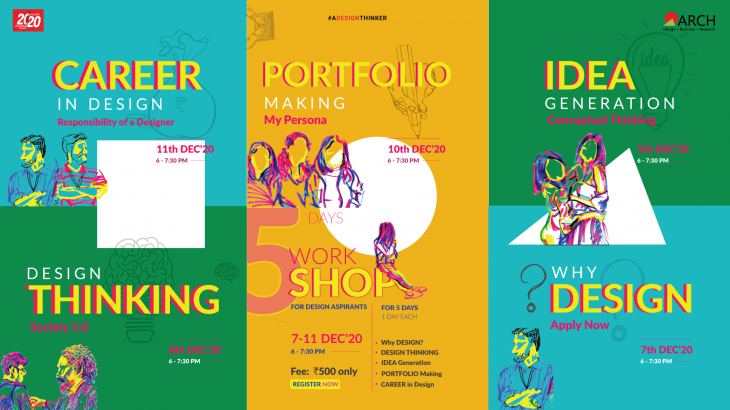Design thinking is a principle and a process at the same time. Aside from design professionals, it is also used by revered academics, musicians, engineers, etc. to solve complex problems of practical and creative utility. With a swift expansion of the design sector in India and across the globe, there is an increasing demand for competence alongside general skills. To stand out in the design sector or any field of profession for that matter, one must develop design thinking deep in their intuitions.
Design thinking is a client-driven approach to carrying out a creative operation. It centers around the needs of people, most importantly, looking to comprehend individuals’ necessities and deriving an achievable strategy to fulfill them.
Design thinking at work by David Dunne is a remarkable book that suggests a similar ideology. The book explains through several examples how design-thinkers come up with innovative & cost-reducing solutions just by being mindful of people’s needs.
Additionally, design thinking is about fixating on the solution rather than the problem. This is what distinguishes itself from organizational thinking in which the subject of focus is always the problem. It is also referred to as “out of the box thinking” because it yields unexpected and unconventional solutions.
Here are the five phases of design thinking that you can incorporate in your project to enhance its efficiency
Empathy:
The principal phase of the Design Thinking measure is to increase an empathic comprehension with the user/customer. By doing so, your work has a purpose; to fulfill the user’s needs. During this phase, a designer gives up all the preconceived notions that they have in mind and engage with people to hear out different ideas. Such discussions and openness lead to beautiful discoveries and as mentioned above; out of the box thinking.
Counseling specialists to discover more about the project you are working on is always a good idea during this phase. Additionally, this phase requires you to be drawing in and identifying with individuals of the same interests to learn from their encounters and inspirations. Soon enough you’ll find yourself immersed in the project with multiple and superior solutions.
Empathy is significant to a human-focused design cycle. It permits design scholars to put aside their suppositions about the world to pick up knowledge from clients and their necessities.
Definition:
During the empathy stage, you will collect a pool of information, and through critical analysis, you can define your project and all the problems posed by it. As mentioned earlier, design thinking is a human-centric approach. Therefore, your responsibility during this stage would be to define the problem from the client’s perspective. This stage will help you to gather & identify multiple solutions. By this phase, you will have a concrete idea of all the features and elements that are to be included in your project.
Although not necessary, it will benefit you to illustrate or jot down every need and problem that you have analyzed. It is also useful to look out for how other professionals in your field meet their client’s requirements. From an outside perspective, the unmet needs would be clearer and you can be mindful of delivering something better.
Ideation:
In the two previous stages, we researched the needs & problems of our client. This stage is about transposing problems into solutions. The key idea of design thinking is that it fixates on solutions rather than the problem. To achieve that, you will have to move forward with your project by converting all problems into ideal solutions.
When you are up & about with a set of solutions, get ready to evaluate them one by one to eliminate everything that doesn’t work out.
Prototyping:
This is the phase where you bring your idea to a physical form. A prototype is an early sample of your final product. The goal of this stage is to get feedback for the design to incorporate changes that increase precision. Your prototypes don’t necessarily need to be all neat and formal. It can be a sketch, an illustration, or the completed product itself; depending on how you choose to go about it.
A prototype can also be used for previous stages like ideation, empathizing, and definition. It puts everything about your project in perspective. Remember to thoroughly analyze all the elements, features, design during this phase. It is also helpful to invite critical feedback from a significant sample size.
Testing:
During the test phase of your project, you revisit the previously drawn solutions and verify its practical existence by trying to solve the problems in question. Try out your solutions to see if it eliminates all the user issues.
This phase leaves you with an in-depth report of your project’s performance & scope for improvement.
Conclusion
The five phases of design thinking when executed in a project bring out the best of it. Most designers who have been using it for years would tell you that they do it sequentially. Let us tell you a little secret, this process doesn’t have to be linear at all! Depending upon the nature of your project, you can choose to pick whatever steps serve you well.
With that being said, design thinking is one of the many premises that Arch College is built upon. Besides necessary skills, our students are trained with the values that ingrain design thinking and creative abilities in their intuitions.
If you’re interested in learning to put the above-mentioned principles into practical use while exploring more about design-related topics, Arch is conducting a 5-day design workshop. This workshop will focus on Career Opportunities in design, Portfolio Making, Design Thinking, and Idea Generation in detail.
